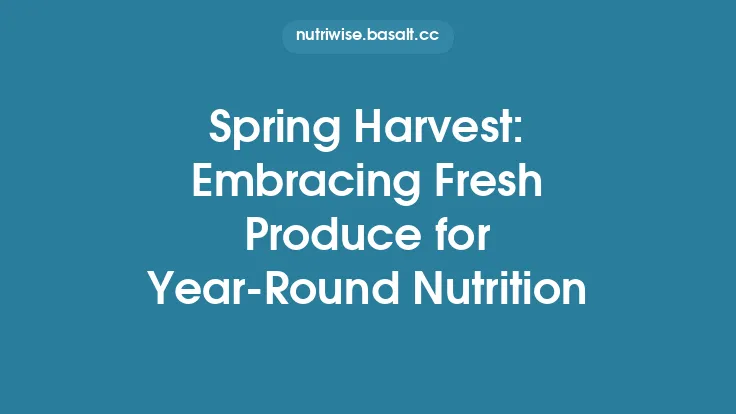When the pantry is stocked with the bounty of one season, the temptation to wait for the next harvest can be strong. Yet the rhythm of daily life rarely aligns with the agricultural calendar, and many home cooks need to prepare meals year‑round. The art of seasonal produce substitution bridges that gap, allowing you to honor local, sustainable sourcing while still delivering the flavors, textures, and nutrition you expect from a dish. Below is a comprehensive guide to making thoughtful, ethical swaps that keep your kitchen in sync with the seasons without compromising on quality.
Understanding the Need for Substitutions
Seasonal produce is defined by the climate and growing conditions of a particular region. When a fruit or vegetable is out of season locally, it is often shipped long distances, harvested before peak ripeness, or grown in energy‑intensive greenhouse environments. Substituting with locally available alternatives reduces transportation emissions, supports regional farmers, and minimizes the waste associated with over‑production. Moreover, many vegetables share similar biochemical pathways, meaning that a well‑chosen substitute can deliver comparable taste and nutritional benefits.
Core Principles for Choosing Seasonal Equivalents
- Botanical Kinship
Plants within the same family often exhibit similar flavor compounds and textures. For example, members of the *Cucurbitaceae* family (zucchini, summer squash, pumpkin, and certain gourds) can frequently replace one another in sautés, soups, or baked dishes.
- Flavor Profile Alignment
Identify the dominant taste notes—sweet, acidic, bitter, umami, or a combination—and seek a substitute that mirrors those sensations. A sweet, mildly acidic fruit like a peach can stand in for a summer tomato in a fresh salsa when paired with a splash of vinegar.
- Texture Compatibility
Consider how the ingredient will behave under heat, moisture, or raw preparation. Firm root vegetables (parsnips, carrots, turnips) can mimic the bite of summer squash when sliced thinly and quickly roasted.
- Culinary Role
Determine whether the produce functions as a base, a garnish, a thickener, or a flavor carrier. A leafy green used for volume in a stir‑fry (e.g., kale) can be swapped with another sturdy green (e.g., collard greens) without altering the dish’s structure.
- Nutrient Parity
While exact nutrient equivalence is rare, many vegetables share key micronutrients. For instance, both broccoli and cauliflower provide substantial vitamin C and fiber, making them interchangeable in many recipes from casseroles to purees.
Mapping Flavor Profiles: A Practical Reference
| Desired Flavor | Seasonal Substitute (Winter) | Seasonal Substitute (Spring) | Seasonal Substitute (Summer) | Seasonal Substitute (Fall) |
|---|---|---|---|---|
| Sweet, juicy | Roasted beetroot | Fresh peas | Ripe tomatoes | Roasted butternut squash |
| Mildly bitter | Endive (stored) | Young arugula | Green beans | Kale (massaged) |
| Earthy depth | Caramelized carrots | New potatoes | Sweet corn | Roasted parsnips |
| Bright acidity | Pickled radish | Lemon‑zested fennel | Lime‑infused cucumber | Apple cider vinegar‑marinated cabbage |
| Umami richness | Sautéed mushrooms | Fresh asparagus | Sun‑dried tomatoes | Roasted mushrooms |
Use this matrix as a starting point; the exact swap will depend on the dish’s cooking method and the desired intensity of each flavor component.
Techniques to Extend Seasonal Availability
Even with the best substitution strategy, some ingredients may still be scarce. Employing preservation methods can keep seasonal produce on hand while maintaining sustainability:
- Freezing: Blanch leafy greens, broccoli, and beans for 2–3 minutes, shock in ice water, then freeze in airtight bags. This locks in color, texture, and most nutrients.
- Drying/Dehydrating: Sun‑dry or use a low‑heat dehydrator for tomatoes, peppers, and herbs. Rehydrate as needed for sauces or soups.
- Fermentation: Turn surplus cabbage, carrots, or radishes into lacto‑fermented vegetables. Fermentation not only preserves but also adds probiotic benefits.
- Pickling: Quick‑pickles (vinegar‑based) can be prepared in under an hour for cucumbers, onions, and even watermelon rind, providing a tangy accent that mimics the brightness of fresh summer produce.
These methods reduce waste, lower demand for out‑of‑season imports, and expand your culinary toolkit.
Leveraging Local Surplus and “Second‑Grade” Produce
Farmers often have surplus or cosmetically imperfect vegetables that are perfectly edible but may not meet retail standards. By purchasing directly from farm stands, community-supported agriculture (CSA) shares, or local co‑ops, you can access:
- “Ugly” Produce: Misshapen carrots, oversized tomatoes, or blemished squash that are still nutritionally intact.
- Over‑Harvest Batches: When a farmer’s field yields more than the market can absorb, they may offer discounted bulk produce.
Incorporating these items into your substitution plan not only cuts costs but also supports a more resilient local food system.
Ethical Implications of Thoughtful Substitutions
Choosing a seasonal substitute is more than a culinary decision; it carries ethical weight:
- Carbon Footprint Reduction: Local, in‑season produce typically requires less refrigeration, packaging, and transport, directly lowering greenhouse gas emissions.
- Economic Equity: By buying from regional growers, you help sustain small‑scale farms that often operate on thin margins, preserving agricultural diversity.
- Food Waste Mitigation: Substituting with surplus or “second‑grade” items diverts edible food from landfills, where it would generate methane.
When you consciously select a substitute, you contribute to a food system that values environmental stewardship and social responsibility.
Practical Tips for Home Cooks
- Create a Seasonal Inventory: Keep a simple chart of what’s in season locally each month. Update it quarterly to stay aware of upcoming produce.
- Batch‑Prep Substitutes: When a particular vegetable is abundant, wash, chop, and freeze portions for future use. This creates a ready‑to‑go pantry of seasonal alternatives.
- Taste Test Before Committing: Cook a small batch of the proposed substitute with the same seasoning you’d use for the original ingredient. Adjust acidity, sweetness, or salt as needed.
- Use Aromatics to Bridge Gaps: Herbs, spices, and aromatics (e.g., garlic, ginger) can compensate for subtle flavor differences between the original and the substitute.
- Document Successful Swaps: Maintain a personal “substitution log” with notes on ratios, cooking times, and flavor outcomes. Over time, this becomes a valuable reference.
Case Studies: Substituting for Specific Dishes
1. Summer Gazpacho (Original: Fresh Tomatoes, Cucumber, Bell Pepper)
- Winter Swap: Roast beets and carrots, blend with a splash of apple cider vinegar, and add finely diced pickled radish for crunch. The earthiness of beets mimics tomato depth, while carrots provide natural sweetness.
- Result: A vibrant, ruby‑red chilled soup with a balanced sweet‑tart profile, retaining the refreshing character of gazpacho.
2. Spring Stir‑Fry (Original: Snap Peas, Asparagus, Baby Corn)
- Fall Swap: Use thinly sliced kohlrabi, sautéed Brussels sprouts, and roasted cauliflower florets. The crispness of kohlrabi stands in for snap peas, while Brussels sprouts deliver a mild bitterness akin to asparagus.
- Result: A hearty, texturally varied stir‑fry that showcases autumn’s robust vegetables while preserving the dish’s quick‑cook ethos.
3. Autumn Risotto (Original: Butternut Squash, Sage, Parmesan)
- Summer Swap: Incorporate roasted sweet potatoes and a hint of smoked paprika, finishing with fresh basil instead of sage. Sweet potatoes supply the creamy starch, and smoked paprika adds depth reminiscent of roasted squash.
- Result: A bright, summery risotto with a comforting mouthfeel, suitable for warm evenings.
Resources and Tools for Ongoing Success
- Local Harvest Calendars: Many county extension services publish printable PDFs that list peak harvest weeks for regional crops.
- Mobile Apps: Platforms such as “Seasonal Food Finder” or “Farm to Table” allow you to input your zip code and receive real‑time alerts on in‑season produce.
- Community Co‑ops: Joining a co‑op often grants access to bulk “second‑grade” items at reduced cost, perfect for substitution experiments.
- Online Substitution Databases: Websites dedicated to culinary science (e.g., “IngredientSwap.org”) provide detailed flavor‑compound analyses to guide swaps.
Bringing It All Together
Seasonal produce substitution is a dynamic practice that blends culinary creativity with sustainability principles. By understanding botanical relationships, matching flavor and texture, and leveraging preservation techniques, you can craft meals that honor the local growing cycle year‑round. Each thoughtful swap reduces reliance on distant supply chains, supports regional farmers, and minimizes food waste—key pillars of ethical eating. Keep a running inventory, experiment with the suggested pairings, and let the rhythm of your local harvest guide your kitchen. In doing so, you’ll enjoy delicious, responsible meals no matter the month.





